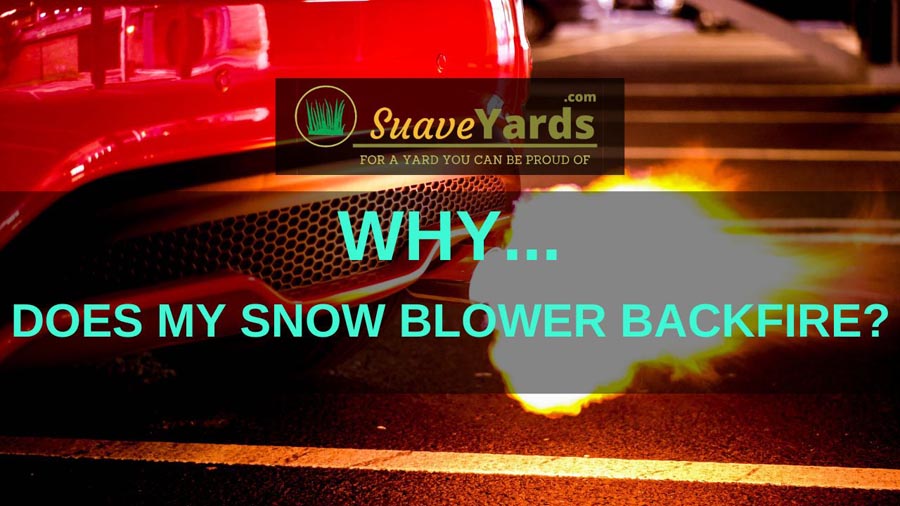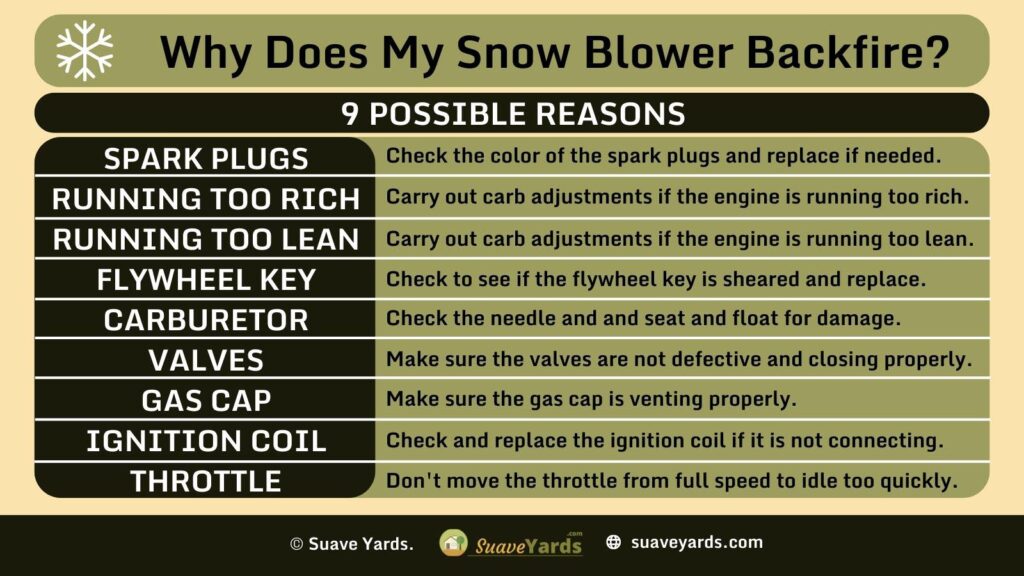
A sudden explosive noise from any small engine will always cause concern.
If it happens when you are desperately trying to clear your yard of snow, it can be even more of a worry!
The good news is, if you are wondering why your snow blower backfires, then we have outlined 9 possible reasons here.
Let’s jump in so you can clear that snow without any anxiety!
Why Does My Snow Blower Backfire?
A backfiring snow blower can be caused by a number of things, including the throttle being shut off too quickly. The first check should be the spark plug, as often replacing them is cheap and easy and will solve the issue. If it doesn’t then the engine could be running too rich or too lean or it could be a problem with the carburetor, valves or ignition coil.
#1: Check the Spark Plug
In situations like this, a good first port of call is to check and possibly replace the spark plug.
Spark plugs can go bad without you realizing and quite often replacing them is a quick, easy and cheap way of solving the problem.
But also the color and condition of a spark plug is a good way of reading the condition of an engine.
- Brown/light gray: Normal, everything is operating optimally.
- Black: Black deposits indicate the air/fuel mixture might be too rich.
- White: White deposits or melted electrodes indicate the air/fuel mixture is too lean.
- Wet: A wet spark plug indicates the engine is flooded.
Check this excellent article to find out in more detail how to read your spark plugs.
#2: Your Snow Blower Might Be Running Too Rich
Black deposits on the spark plug indicate that your engine might be running too rich and if that is the case it is not unusual for it to backfire.
A flooded engine is another symptom of an engine running rich, so if the spark plug is wet as well you can be almost certain this is the issue.
Try running your snow blower with the choke slightly open. If it runs fine, again this is a sign there is too much fuel in the mix for it combust properly.
If you have an adjustable carburetor then simply use that to adjust the fuel/air mix and it should solve the problem.
If not you can buy a replacement carburetor that is adjustable.
Or you can try checking for any clogged jets and cleaning them if necessary. It is also worth taking a look at the throttle cable to see if that needs adjusting.
RELATED ===> Buyers Guide: The Best Snow Blowers on the Market
#3: Your Snow Blower Might Be Running Too Lean
On the other side of the coin, white deposits or melted electrodes indicate that your snow blower might be running too lean.
A lean running carburetor will also make the engine too hot, and cause the muffler to glow, so this is another telltale sign if the engine is backfiring.
Again, if you can, try adjusting the fuel/air mix. If not try cleaning the carburetor jets and any filters and replace the diaphragm.
Or replace or rebuild the entire carburetor.
#4: Check the Flywheel Key
The flywheel key is an important part of any small engine.
It fits into the crankshaft and engages the flywheel, and importantly it absorbs the shock if you accidentally strike something solid
If the flywheel key is sheared, or damaged in any way, it could mean the timing of your blower is off enough so that it starts, but as soon as you try to run it under a load it backfires.
If you notice the timing is off, then take a look at the flywheel key and replace it if necessary.
#5: Take a Closer Look at the Carburetor
Another potential cause of an engine backfiring could lie with a defective needle and seat and float in the carburetor.
If the float is bent, or something is leaking inside of it, it can throw off all kinds of things and cause the governor to try and counteract the situation.
The result is the engine might hunt and search or backfire.
Check the needle valve is seating properly, thoroughly clean the carburetor and if the problem doesn’t go away change the needle and the seat and float.
If this still doesn’t solve the problem it is worth checking the entire fuel system.
Change the fuel filter, and blow out the tank, lines and every carburetor passage with compressed air.
RELATED ===> What Time Can You Use A Snow Blower?
#6: Look For Defective Valves

A defective valve can cause a loss of compression and the subsequent backfiring of an engine.
Carbon build-up might mean the valves aren’t closing properly, this is bad for the valves and the engine.
And if the valves aren’t closing properly the engine will pull on a richer mix of fuel to keep it running.
Buy a can of seafoam and spray it into the valve intake whilst it is running. This can clean the valves and pistons and might solve the problem.
If that doesn’t work then there are two more things to look at:
- Check the valve clearance. If it is too small you could try removing the valve and grinding a small amount off of it to help it close fully.
- Check if the valves are bent or damaged. If they are you will have to replace them.
#7: Make Sure the Gas Cap is Venting Properly
If your blower starts backfiring, try removing the gas cap temporarily to see if this solves the issue.
If it does, then it is simply a case that the gas cap is not venting properly.
A quick and easy fix is to drill a hole in the gas cap and put it back on.
#8: Check the Coil
A bad ignition coil can have a similar effect to a below-par carburetor.
That means your snow blower might be fine running at a low RPM, but the longer it runs for, or if you try running it at a higher RPM, it could well start backfiring.
If this is the case, check all the wiring to the coil and plug and if necessary replace the coil and/or ignition circuit and plug.
RELATED ===> How Much is Enough? Snow Blower Horsepower: A Comprehensive Guide
#9: You Are Closing the Throttle Too Suddenly
If you are moving from full speed to idle too quickly the likelihood is that your snow blower will backfire.
At full speed the crank is spinning in fast and pulling in lots of air and fuel.
Then suddenly you are cutting down the fuel, but lots of air is still being drawn in. The unburned gas is compressed by the rising of the piston and will explode.
Simply bring down the RPMs, more slowly and evenly.
Final Thoughts

Hopefully amongst these scenarios, you have found the reason why your snowblower is backfiring.
Also be careful not to mistake backfire for pre-ignition.
A backfire is notable by the flame coming out of the carburetor, whereas pre-ignition is raw fuel that ignites in the cylinder incorrectly and is often caused by bad gas.
But as you can see from this article and the infographic there are a whole number of reasons why snow blowers backfire, and it is surprisingly common.
Start by checking and replacing the spark plugs if necessary, then see if your engine is running too rich or too lean, and then work from there.
Once it is solved then you can blow away that snow with complete peace of mind!
